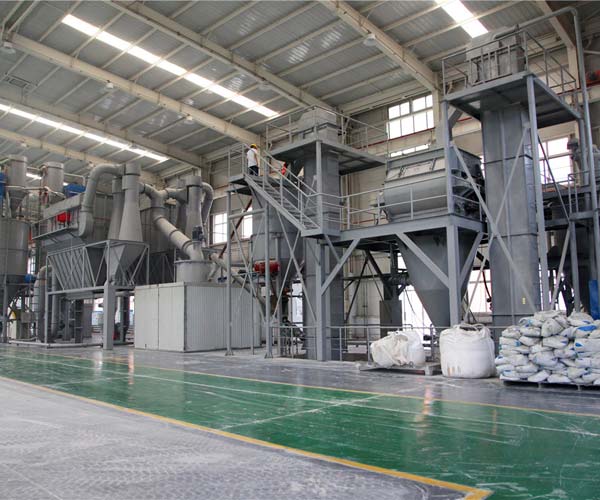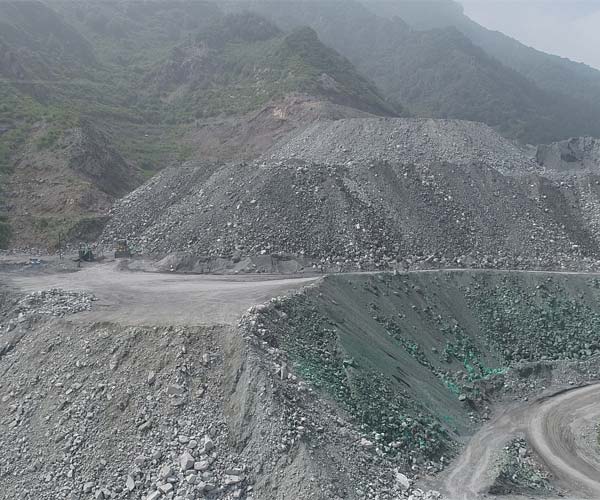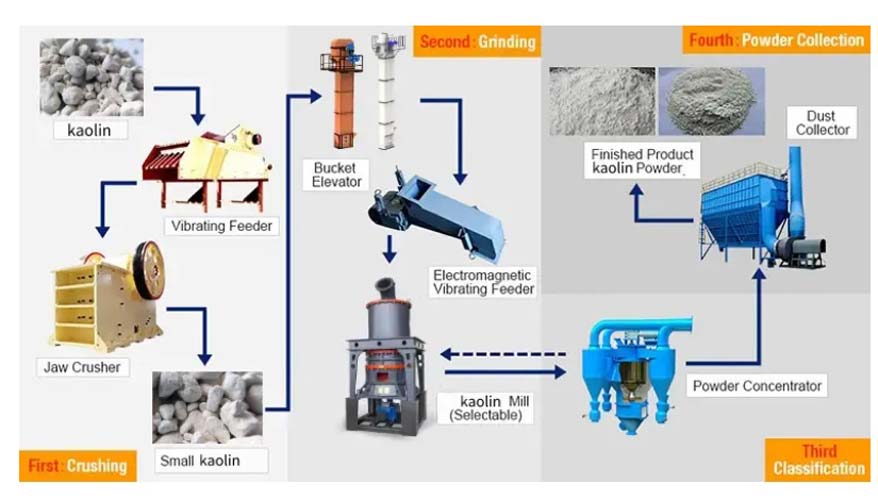
Kaolin powder processing involves a series of techniques that transform raw kaolin rocks into a fine powder, enhancing its properties for diverse industrial applications. Crushing and grinding reduce the size of kaolin rocks, while beneficiation techniques remove impurities and enhance purity.
24 Online Service

Kaolin, also known as china clay, is a fine white clay primarily composed of the mineral kaolinite. The formation of kaolin deposits is a fascinating geological process that takes place over millions of years.
Kaolin deposits are formed through a complex interplay of various geological processes. It begins with the weathering of rocks rich in feldspar and other aluminum-bearing minerals.
The weathering of these rocks occurs through the action of water, which chemically decomposes feldspar minerals into clay minerals like kaolinite.
Kaolin deposits can be found on all continents, but the largest and most commercially significant ones are concentrated in specific regions. Some of the major kaolin-producing countries include the United States, Brazil, the United Kingdom, China, and Germany.
Kaolin mining is a meticulous process that involves the use of advanced equipment and techniques to extract the clay from its natural deposits. There are two main methods used for kaolin extraction: open-pit mining and underground mining.
Open-pit mining is the most common method used to extract kaolin from large, shallow deposits. In this approach, overburden (the layer of soil and rocks covering the kaolin deposit) is removed first to expose the clay. Heavy machinery, such as bulldozers and backhoes, is employed to remove the overburden and expose the kaolin ore.
Once exposed, the kaolin ore is then extracted using powerful hydraulic equipment, such as draglines or power shovels. The ore is then transported to the processing plant for further refinement.
Underground mining is employed when the kaolin deposit is deep and not suitable for open-pit mining. This method involves the creation of tunnels and shafts to access the kaolin ore beneath the surface. Although less common than open-pit mining, it can be a viable option for certain high-quality deposits.
Mining, like any industrial activity, can have significant environmental impacts. Open-pit mining, in particular, can result in deforestation, habitat destruction, and disruption of local ecosystems. The removal of overburden and the disturbance of the landscape can lead to soil erosion and changes in the hydrology of the area.
In addition to these physical impacts, mining operations can generate dust and particulate matter, potentially affecting air quality. The use of heavy machinery and transportation vehicles can also contribute to greenhouse gas emissions and noise pollution.
To mitigate these environmental impacts, responsible mining practices and reclamation plans are essential. Reclamation involves restoring the mined areas to a state that resembles their original condition, promoting ecological balance and sustainable land use.
Before kaolin can be used in various industrial applications, it undergoes several pre-processing steps to prepare the raw material for further refinement.
Kaolin deposits may contain variations in purity and mineral content. To achieve a consistent quality and composition, different deposits are blended together, and the raw materials are thoroughly mixed.
Beneficiation is the process of removing impurities and non-kaolin materials from the raw ore. Common impurities include iron oxide minerals, titanium oxides, and organic matter. Beneficiation techniques may involve magnetic separation, flotation, or other physical and chemical processes to achieve the desired purity.
After beneficiation, the kaolin slurry is typically dried to reduce moisture content. Drying facilitates handling and transportation of the material and is essential for certain industrial applications.
The removal of impurities from raw kaolin is crucial because impurities can adversely affect the properties and performance of the final kaolin product. For instance, iron oxide impurities can give the clay a yellow or brownish tint, reducing its value for applications where whiteness is critical, such as in the paper and ceramic industries.
Moreover, non-kaolin materials may affect the behavior of the clay during processing, altering its plasticity and firing characteristics. For specific applications, such as in the production of high-quality ceramics, the absence of impurities is essential to achieve the desired product properties.

Kaolin, a soft white clay mineral, is widely used in various industries due to its versatile properties. To transform raw kaolin rocks into a fine powder suitable for different applications, several processing techniques are employed.
To cater to the diverse demands of various industries, raw kaolin extracted from mines undergoes extensive processing in specialized kaolin processing plants. The processing steps are designed to remove impurities, enhance the brightness and particle size, and modify the mineral’s properties to suit specific applications.
The journey of kaolin begins with the extraction of raw materials from mines. The extracted rocks are typically large and irregularly shaped. The first step in processing kaolin involves crushing these rocks into smaller, more manageable pieces. Jaw crushers or gyratory crushers are commonly used for this initial size reduction. After crushing, the next step is grinding, where the crushed rocks are further processed to attain a finer particle size.
In the grinding process, kaolin rocks are ground into a fine powder using various mills such as ball mills, hammer mills, or jet mills. The choice of the mill depends on the desired particle size and the properties required for the end application. The grinding process ensures the liberation of kaolin particles from impurities and other minerals, resulting in a high-purity kaolin powder with specific properties.
Kaolin rocks obtained from mines often contain impurities, such as iron oxide minerals and titanium. Beneficiation techniques are applied to remove these impurities and enhance the quality and purity of kaolin. One common beneficiation method is froth flotation, where certain chemicals are used to selectively separate impurities from kaolin.
In froth flotation, the kaolin is mixed with water and chemicals, and air bubbles are introduced. The air bubbles selectively attach to the hydrophobic impurities, lifting them to the surface, where they can be easily skimmed off. This process helps in obtaining a high-quality kaolin with improved brightness and whiteness, making it more suitable for applications in industries like paper, ceramics, and cosmetics.
Drying is a crucial step in kaolin processing as it reduces moisture content, making the kaolin powder more stable and easier to handle. Excess moisture in the final product can lead to issues during transportation, storage, and application. Improper drying may also cause undesirable changes in the properties of kaolin, impacting its performance in various applications.
There are several methods employed for drying kaolin, including air drying, spray drying, and calcination. Air drying involves spreading the wet kaolin in thin layers and allowing natural air circulation to remove moisture over time. Spray drying utilizes hot air to evaporate moisture rapidly, resulting in a fine powder with excellent flowability. However, calcination is sometimes preferred when certain modifications to the kaolin properties are required.
Calcination is a specialized thermal treatment process used to modify the properties of kaolin, especially in applications where specific attributes are desired. During calcination, kaolin is heated to high temperatures (typically above 600°C) in rotary kilns or fluidized bed calciners. This process alters the crystal structure of kaolin and can improve properties such as brightness, opacity, and electrical resistivity.
One example of a modified kaolin obtained through calcination is metakaolin, which finds application in the production of high-performance concrete. Metakaolin, with its enhanced pozzolanic reactivity, contributes to increased concrete strength and durability, making it valuable in construction and infrastructure projects.
Particle size is a critical parameter that significantly influences the properties and performance of kaolin in various industrial applications. To achieve specific particle size distributions, classification techniques are employed. Common methods include wet screening, centrifugation, and hydrocyclones.
In the paper industry, kaolin with a fine particle size is preferred as it improves opacity and printability. On the other hand, coarser kaolin is more suitable for applications in ceramics, where it contributes to better strength and firing properties.
The control of particle size in kaolin is of utmost importance in different industries. In the paper industry, smaller particle sizes provide better coverage and ink absorption, resulting in high-quality glossy paper. Coarser kaolin particles, however, are beneficial in the production of ceramic materials, where they act as a reinforcement and reduce shrinkage during firing.
In the rubber industry, the particle size of kaolin affects the mechanical properties of rubber compounds. Fine kaolin particles enhance reinforcement, while coarser particles contribute to better abrasion resistance.
Moreover, the paint and coatings industry relies on kaolin with specific particle size distributions to control viscosity, improve opacity, and maintain stability in the final product.

Kaolin, a fine white clay with a rich history dating back centuries, has emerged as a versatile mineral with an array of applications across various industries. Derived from the mineral kaolinite, this soft and pliable substance finds use in a diverse range of fields, owing to its unique properties and natural abundance. From traditional ceramics to modern high-tech applications, the uses of kaolin powder continue to evolve, making it an indispensable resource for both industrial and consumer needs.
One of the most traditional and significant applications of kaolin is in the production of ceramics and pottery. Due to its plasticity, non-shrinking properties during firing, and ability to improve the strength and structure of clay bodies, kaolin is an essential component in ceramic formulations. It acts as a crucial binder, enabling artists and manufacturers to shape their creations with ease. Furthermore, kaolin’s presence helps control the firing temperature and enhances the finished product’s whiteness and texture, making it ideal for high-quality porcelain and fine china.
Kaolin’s unique properties extend to the paper and pulp industry, where it plays a crucial role in paper production. By acting as a filler and coating material, kaolin improves paper’s smoothness, brightness, opacity, and ink receptivity. It also reduces the need for expensive wood pulp, making the paper more cost-effective. Moreover, kaolin’s presence enhances the formation and retention of fibers during the papermaking process, leading to increased paper strength and reduced bleed-through.
The paint and coatings industry benefits from the addition of kaolin in various formulations. Due to its light scattering properties and ability to provide bulk, kaolin is a popular extender in paints and coatings. It improves the paint’s coverage, reduces costs, and enhances its overall performance. Moreover, kaolin’s fine particle size contributes to the smooth texture of paint, making it an excellent choice for high-quality finishes.
In the realm of pigments, kaolin is sometimes used as an alternative to titanium dioxide, which can be expensive. Kaolin-based pigments offer comparable opacity and whiteness, while also being more environmentally friendly and sustainable.
Kaolin finds a home in the plastics and rubber industry as a reinforcing agent and filler. When added to polymers, kaolin improves mechanical properties, enhances dimensional stability, and increases heat resistance. Its incorporation also results in reduced shrinkage during the molding process. In the rubber industry, kaolin imparts strength, resilience, and abrasion resistance to rubber products such as tires, hoses, and belts.
In the pharmaceutical and cosmetic industries, kaolin’s gentle and absorbent nature makes it a valuable ingredient. It is commonly used in skincare products like face masks, cleansers, and powders due to its ability to absorb excess oils and impurities, leaving the skin feeling fresh and rejuvenated. Additionally, kaolin’s natural inertness and non-allergenic properties make it safe for topical use, making it suitable for sensitive skin types.
The agricultural and horticultural sectors also benefit from kaolin’s applications. When applied as a clay-based film on plant surfaces, kaolin acts as a protective barrier against pests and harmful UV radiation. This practice, known as “kaolin clay coating” or “white kaolin clay application,” helps reduce insect damage and heat stress while improving crop yields. Furthermore, kaolin’s moisture-retaining properties can aid in soil conditioning and act as a carrier for agricultural chemicals, ensuring efficient and targeted application.
Apart from traditional ceramics, kaolin finds applications in advanced ceramics and refractories. Its high alumina content and low impurities make it suitable for producing high-quality ceramics used in electrical insulators, spark plugs, and other electronic components. In refractory applications, kaolin’s heat resistance and low thermal expansion enable it to withstand extreme temperatures, making it an essential component in the manufacture of crucibles, kiln furniture, and refractory bricks.
Kaolin’s adsorbent and cation exchange properties render it valuable for wastewater treatment. It can remove various pollutants, including heavy metals and organic compounds, from contaminated water. Its low cost and natural abundance make it an attractive option for water treatment plants and industries seeking sustainable solutions for managing their effluents.
Our Projects
Copyright © ZENITH, All Right Reserved.
